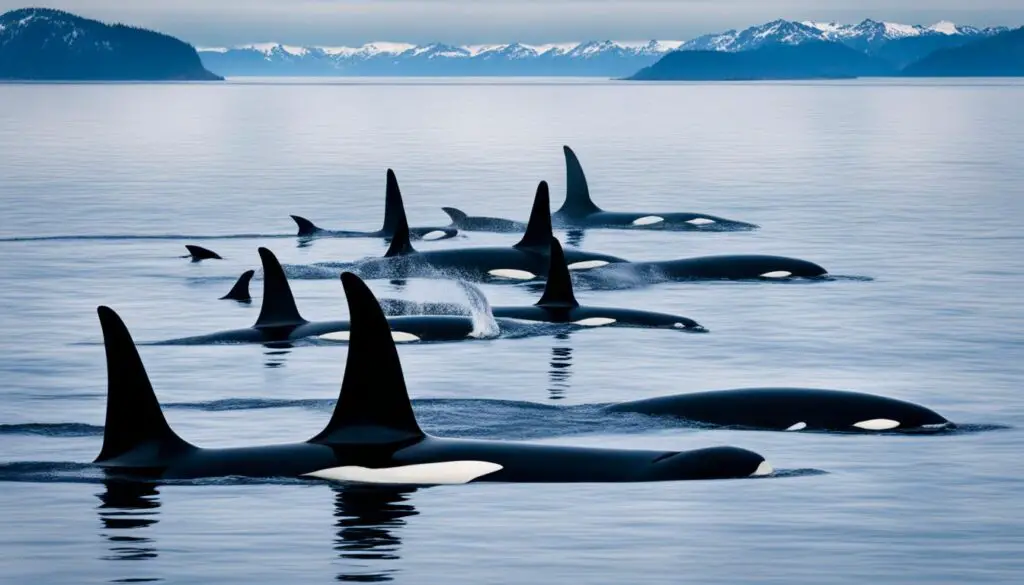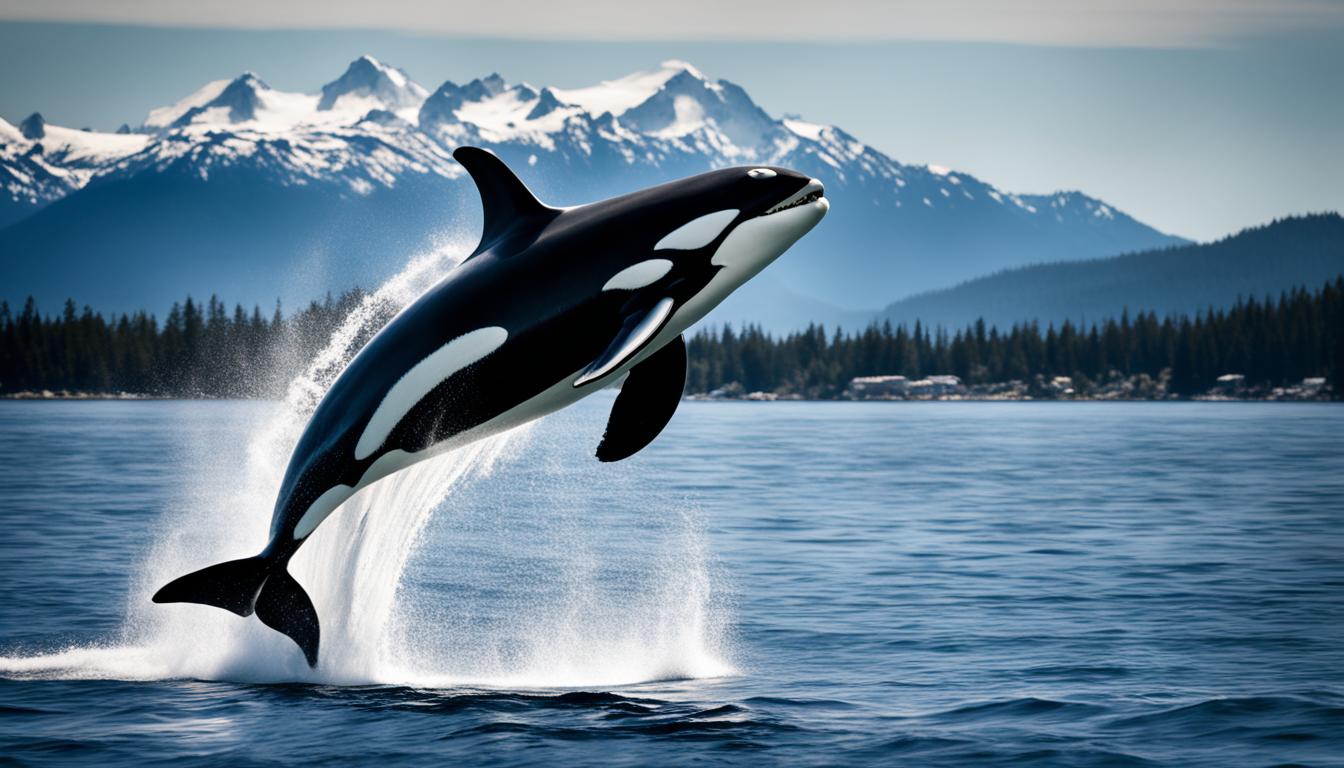Have you ever seen an orca, also known as a killer whale, and wondered if they are dangerous to humans? These marine mammals are often misunderstood because of their powerful reputation and hunting skills. It’s important to look into how humans and orcas interact to understand the safety concerns.
Historically, there’s a big difference between wild orcas and those in captivity. This difference challenges the idea that orcas often attack humans. Let’s explore the world of orcas to learn more about their behavior and interactions with humans. This will help us understand the safety risks better.
Understanding Orcas: The Misunderstood Marine Mammals
Orcas, or killer whales, are fascinating creatures known for their intelligence and unique social structures. They are not just big fish; they have a lot going on under the surface. Let’s dive into the world of orcas and explore their varied characteristics and behaviors.
Characteristics and Behavior of Orcas
One of the most striking things about orcas is their size. Adults can weigh up to 12,000 pounds and reach lengths of 20-26 feet. Their black and white coloration helps them blend in with the ocean and aids in hunting. Orca behavior is complex, showing social structures, communication, and playful interactions.
- Social Animals: Orcas live in matrilineal pods, which often include multiple generations.
- Hunting Techniques: They use sophisticated strategies to catch prey, often working together.
- Cognitive Abilities: Known for their intelligence, orcas can learn and adapt their behaviors over time.
The Name “Killer Whale” Explained
The name “killer whale” comes from early whalers who saw orcas hunting large whales. Despite their name, they mostly eat fish, seals, and sometimes smaller whales. This shows how complex their role is in the ecosystem.
| Characteristic | Details |
|---|---|
| Size | 20-26 feet long, weighing between 8,000-12,000 pounds |
| Coloration | Black body with distinctive white patches |
| Social Structure | Matrilineal pods with strong familial bonds |
| Diet | Primarily fish, seals, and occasionally other marine mammals |
Are orcas dangerous to humans?
Orcas and humans rarely meet, but when they do, it’s not usually a threat. Most times, orcas don’t show aggression towards people. This shows they’re not naturally dangerous to humans.
Rare Occurrences of Human Interactions
Most times, humans and orcas don’t cross paths. When they do, it’s usually without harm. There are few stories of orcas being aggressive to people. One old story from the 1950s talks about a human being killed, but it’s not proven.
This tells us orcas are mostly not a threat unless something unusual happens. They act differently in different situations.
Historical Accounts of Orca Encounters
History shows orca encounters vary a lot. In the wild, they’re mostly peaceful. But in places like theme parks, things can go wrong, like what happened to trainer Dawn Brancheau in 2010. This highlights the importance of understanding orcas and their environments.
It’s crucial to approach orcas with respect and knowledge. This way, we can have safe and positive interactions with them.
Orca Behavior: Wild vs. Captivity
Comparing orca behavior in the wild and captivity shows us a lot about these amazing animals. In the wild, orcas live in complex social groups. This shapes their actions and how they interact with humans. Captive orcas, however, face challenges from being in small spaces, leading to emotional and behavioral problems.
Captive Orcas and Their Complex Behaviors
Captive orcas live far from their natural homes. They don’t have the social groups that are key to their happiness. This can cause a range of issues, like *stress-induced aggression* and *repetitive, abnormal actions*. These problems often come from the tough conditions they face, making us question their mental health.
Wild Orcas and Their Interaction with Humans
In the wild, orcas are smart and work together, using complex hunting methods. They can have non-aggressive meetings with humans, showing how smart and flexible they are. When we see orcas in the wild, it’s key to keep a safe distance. Positive *interactions with humans* can help us learn more about them and protect them.

| Aspect | Wild Orcas | Captive Orcas |
|---|---|---|
| Social Structure | Live in pods with complex social networks | Isolated from natural social groups |
| Behavioral Issues | Minimal issues, natural behaviors dominate | Often display stress-related and abnormal behaviors |
| Interaction with Humans | Non-aggressive; can be curious and engaging | Risk of aggression due to stress and confinement |
| Communication | Rich vocalizations, nuanced social signals | Limited communication, often repetitive actions |
The Science Behind Orca Attacks
Learning about orca attacks and their diet helps us understand how they interact with humans. Orcas, also known as killer whales, mainly eat fish, seals, and smaller whales. They are top predators in the ocean. Their hunting skills don’t usually include humans, showing they don’t see us as prey.
Understanding Orca Diet and Preferences
What orcas eat changes with their location and group. Some eat salmon in the Pacific Northwest, while others hunt seals in the Arctic. Their smart hunting shows their adaptability and teamwork in catching food.
Instances of Orca Attacks on Humans
Human encounters with orca attacks are very rare. When they do happen, it’s often because orcas mistake humans for seals in unclear waters. These cases are usually playful, not aggressive. Experts say orcas rarely go after humans, making human-orca interactions safe and friendly.
Safety Tips for Marine Wildlife Encounters
When you meet orcas, put your safety first and protect them too. Keep a safe distance of at least 100 yards. This keeps you out of harm’s way and helps the whales stay safe. Always follow the rules for seeing marine animals and watch for any signs of trouble in them.
How to Maintain Safety Around Orcas
Stay calm and quiet when watching orcas. Don’t make sudden moves that might scare them. If you get to see these whales, watch how they act but stay back. Being careful like this keeps you safe and helps protect their natural ways.
Best Practices for Whale Watching
Picking a good whale watching tour is key. Choose ones that care for the ocean and teach visitors how to be respectful. This way, you’ll have a great time and respect the whales. Knowing and following these tips helps us all get along with these amazing sea creatures.
FAQ
Are orcas dangerous to humans?
Wild orcas are not usually dangerous to humans. They rarely interact with people and are not aggressive. However, orcas in captivity can be a different story due to stress and behavioral problems.
What factors influence orca behavior towards humans?
Environment, stress, and social dynamics affect orca behavior. In the wild, orcas and humans often have peaceful encounters. But in captivity, orcas may act aggressively due to stress.
Can orcas attack humans in the wild?
Wild orcas rarely attack humans. There was one reported incident in the 1950s, but it’s not confirmed. They usually see humans as non-prey.
How do captive orcas behave differently than wild orcas?
Captive orcas often show aggression due to being in a small space. Wild orcas live in groups and hunt together. This leads to peaceful interactions with humans.
How should I approach orcas when encountered in the wild?
Keep a safe distance of at least 100 yards from orcas in the wild. Follow local rules and respect their space to stay safe and protect them.
What should I know before participating in a whale-watching tour?
Pick tours that are eco-friendly and focus on responsible practices and learning. This way, you’ll have a safe experience and won’t disturb the marine life.
What is the diet of orcas, and how does it relate to human interactions?
Orcas eat fish, seals, and sometimes other whales. They don’t eat humans. Attacks on humans usually happen because they misunderstand the situation, not because they want to hunt us.
What are the common misconceptions about orcas?
Many think orcas are dangerous because they’re called “killer whales.” But in their natural setting, they don’t pose a big threat to humans.







